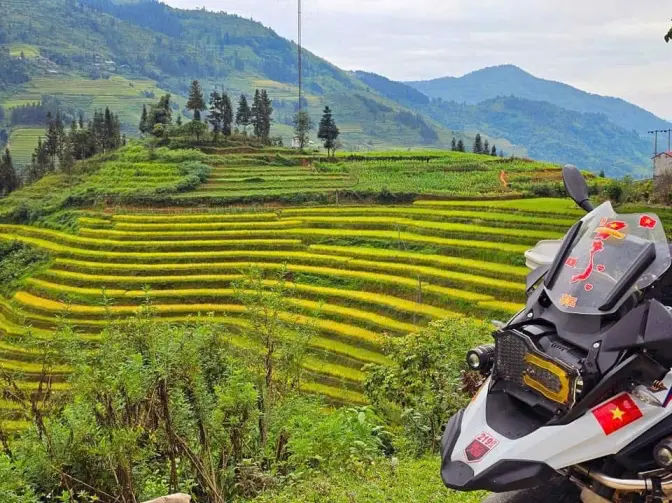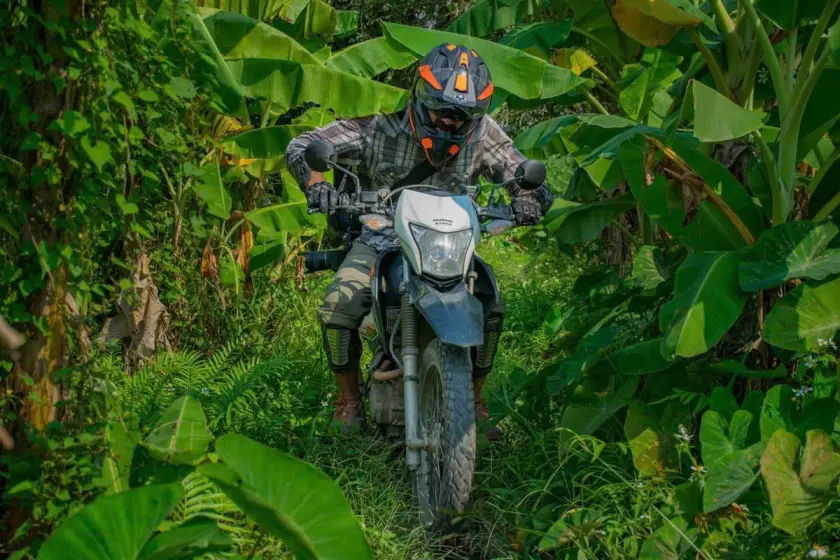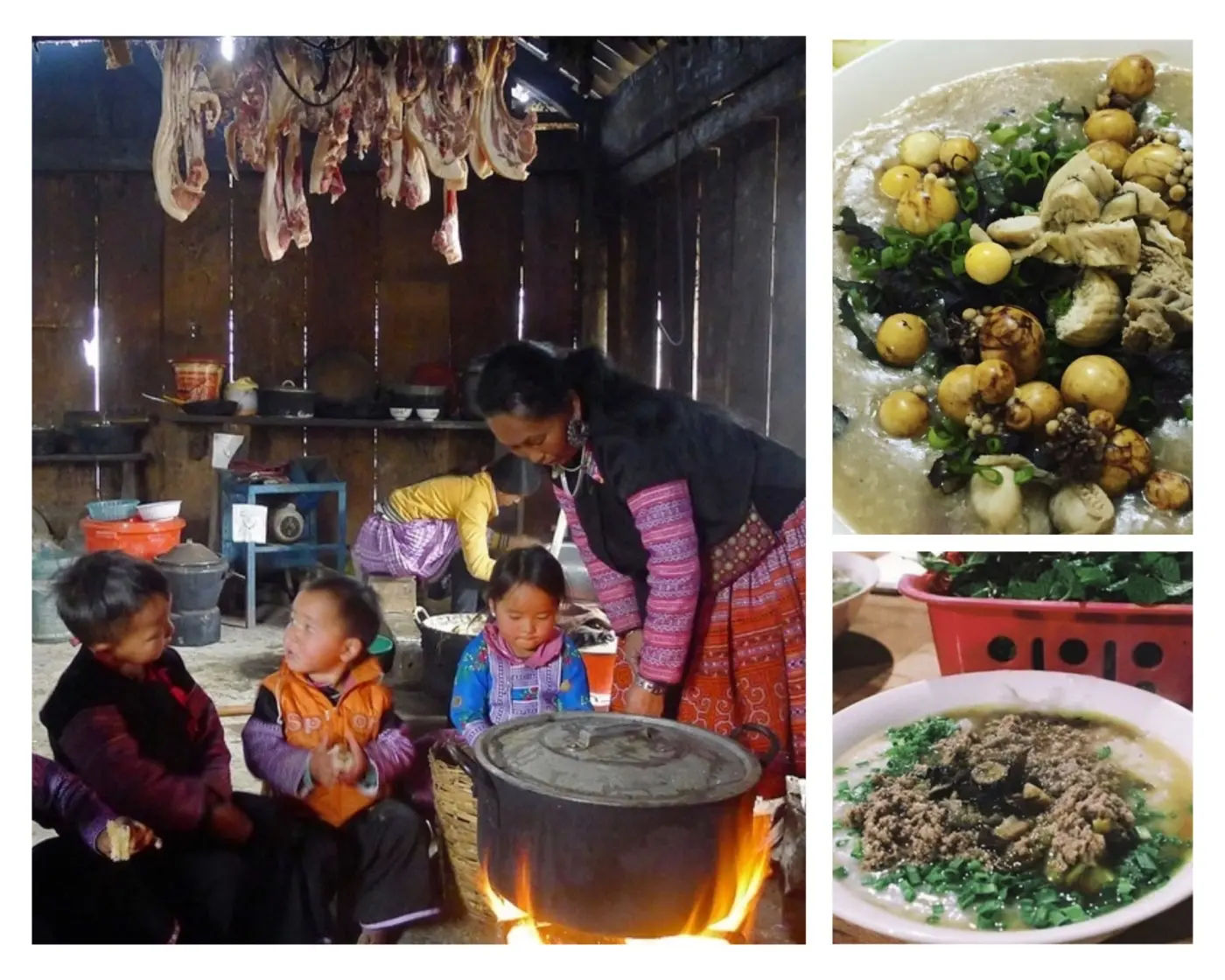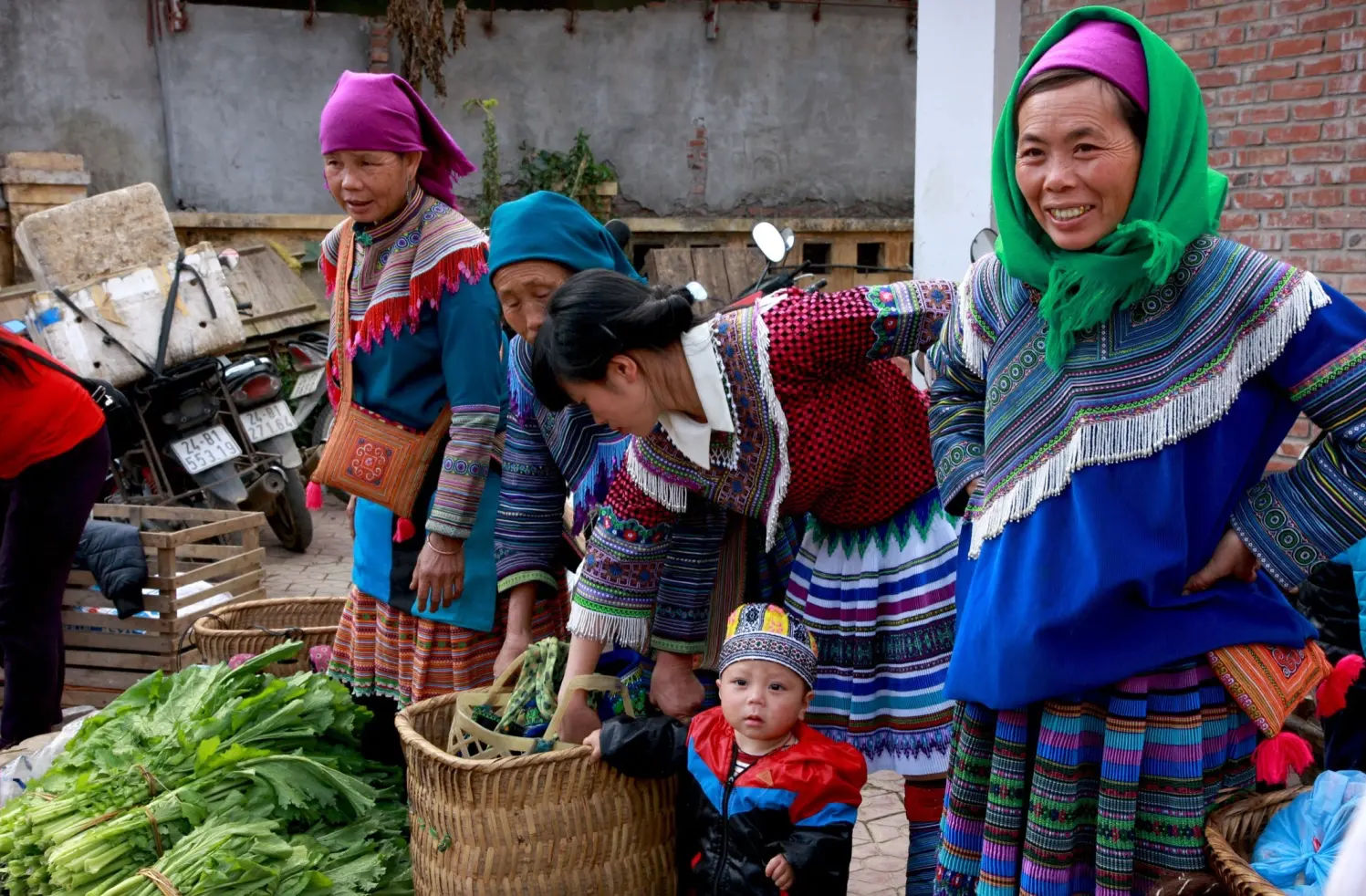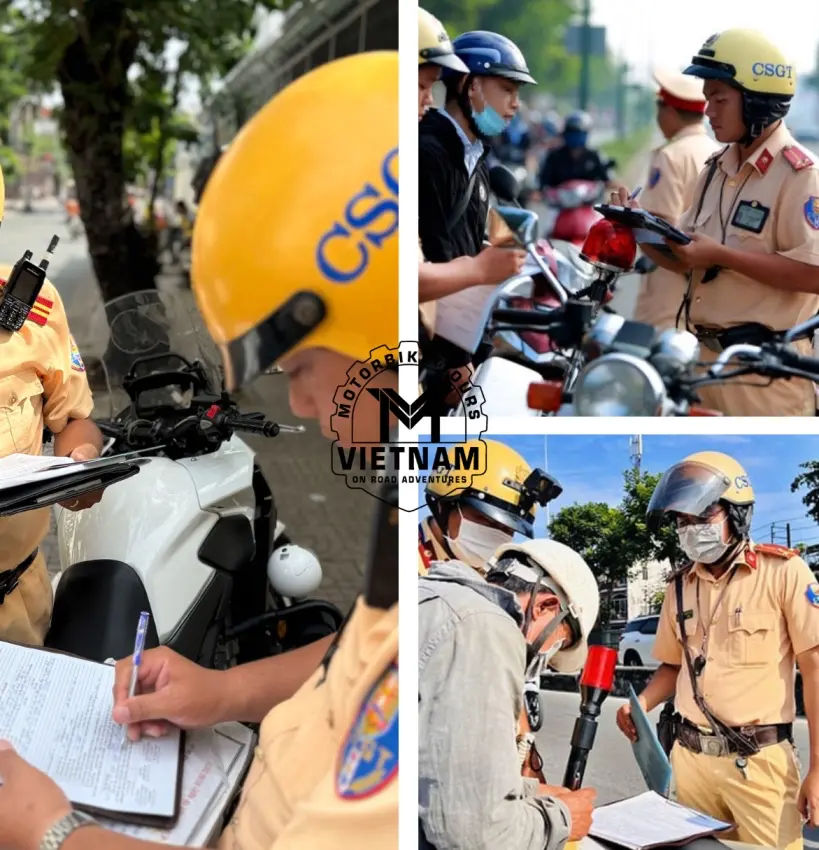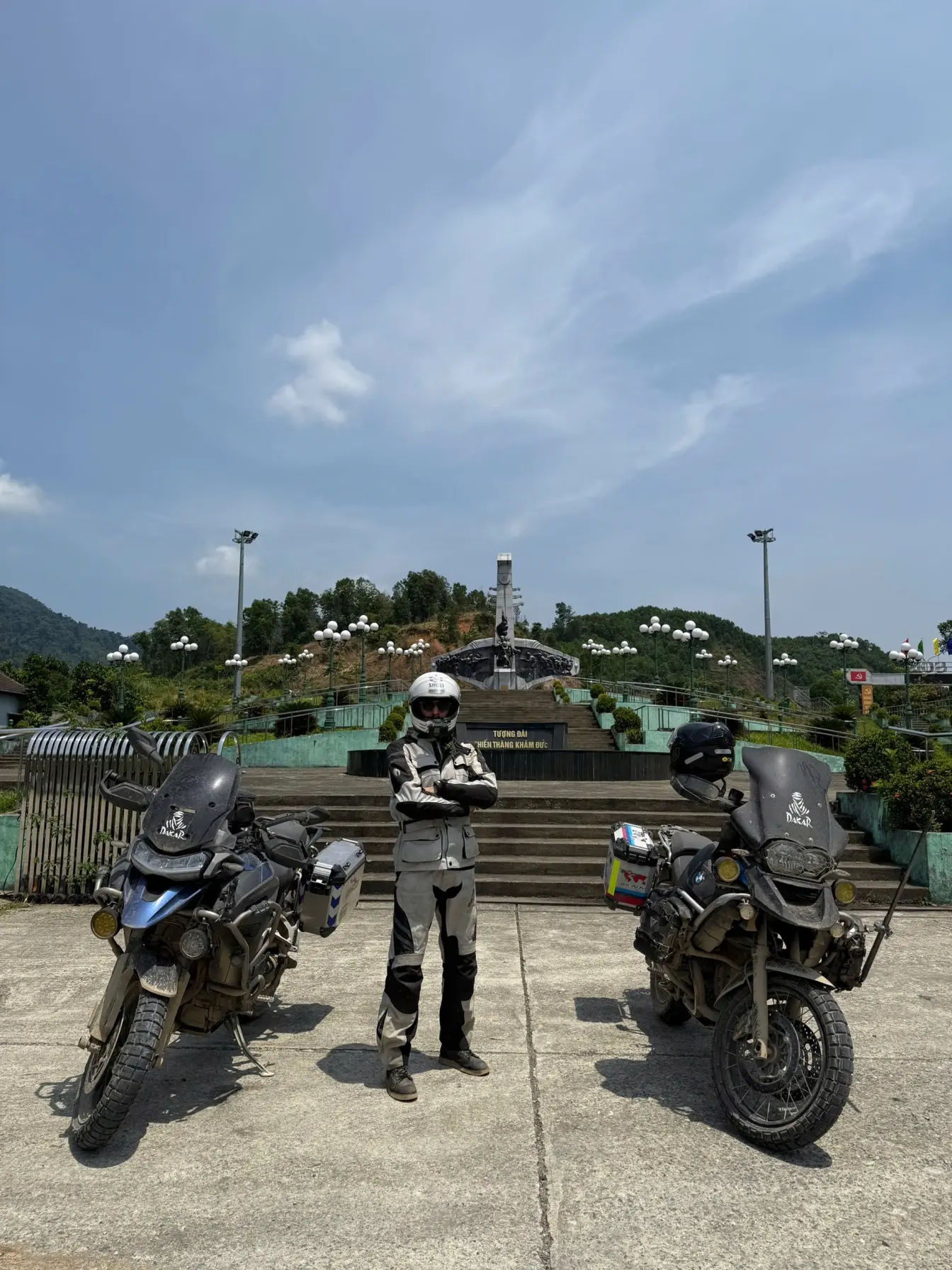
If you’ve never heard of the Y Tý Loop, picture off-road to a remote mountain route in northern Vietnam (Lao Cai), where clouds roll across terraced rice fields and tiny villages seem frozen in time. It’s less polished than Sapa, far quieter than Ha Giang, and yet, it carries its own magic. The roads feel raw, the landscapes untouched, and every turn makes you stop just to soak it all in.
Why Choose to ride the Sapa – Y Ty Loop?
If you’ve never heard of the Y Tý Loop, picture a remote mountain route in northern Vietnam (Lao Cai), where clouds roll across terraced rice fields and tiny villages seem frozen in time. It’s less polished than Sapa, far quieter than Ha Giang, and yet, it carries its own magic. The roads feel raw, the landscapes untouched, and every turn makes you stop just to soak it all in.
The first question is: What sets the Y Tý Loop apart from places like the Ha Giang Loop or Sapa is its seclusion. Ha Giang has become a rite of passage for all types of travelers, backpackers and to be honest, even though it’s an amazing ride, it’s becoming way too touristy, while Sapa draws crowds of tour buses.
Y Tý, on the other hand, feels like a secret (I bet 7 out of 10 of Vietnamese even not heard of it!). The roads are rougher, the homestays more basic, and the pace of life slower. You ride through villages where ethnic minority groups still wear traditional clothes daily—not for tourists, but because it’s simply their way of life. The experience feels authentic in a way that’s hard to find elsewhere.
- Check out Motorbike tours in Vietnam
Who would I recommend the Y Tý Loop to?
Honestly, it’s not for everyone. If you want comfort and convenience, stick to Sapa and it’s tourist track. But if you’re the kind of traveler who loves riding the remote roads and see hidden gems, photographing landscapes before anyone else discovers them, or connecting with cultures on their own terms, then Y Tý will blow your mind. Adventurers thrive here, photographers can’t stop shooting, and cultural travelers leave with stories they’ll tell for years. Casual tourists? They might find the journey a bit too demanding—but if they’re willing to rough it, they’ll never forget it.
Area map to Y Ty
The Route Planning to Y Ty
- Total Distance from Hanoi: 370km / ~7 hours ride
- From Sapa: 80km / ~3 hours
- Duration: Best for weekend, or 3 days / 2 nights
- Road Conditions: Paved scenic back roads but rocky for the last 80km (from Lao Cai).
- Scenery: Lush mountains, rivers, rice terraces, home to minority villages.
Where Does the Y Tý Loop Start and End?
Most off-road riders start the Y Tý Loop from Lào Cai City or Sapa, since both towns connect easily to Hanoi by train or bus. From there, the loop winds through Bát Xát, Trịnh Tường, Y Tý, and several small border villages before circling back. The full ride usually covers 180–200 km, depending on which detours you take. For me, two days felt rushed. I’d recommend at least three days if you want time to stop for photos, explore markets, and just breathe in the mountain air.
Best Way to Travel the Y Tý Loop
If you ask me, the motorbike is the best way to do this loop. The freedom to stop whenever the clouds roll over a rice terrace or when you see a local market is priceless. Cars work too, but you lose that intimate connection with the road. As for bicycles—let’s be honest, this route will test even the toughest cyclists. The climbs are brutal, the weather unpredictable, and you’ll need serious stamina. Guided tours exist, but part of Y Tý’s charm is its rawness. I loved figuring things out on my own, even if it meant asking villagers for directions in broken Vietnamese.
Road Conditions
The roads on the Y Tý Loop are a mixed bag. Some stretches are freshly paved and smooth, while others turn into dirt tracks full of potholes. During the rainy season (May to September), landslides and mud can slow you down or even block certain sections. When I rode in late autumn, the air felt crisp, the skies clear, and the roads manageable. My advice: check the weather before you go and ride with a flexible plan. If the mountains want to change your schedule, they will.
Combining Y Tý With Other Destinations
Travelers rarely visit Y Tý in isolation. Most people combine it with Sapa for a taste of the more popular trekking trails, or with Bắc Hà to catch the famous Sunday market. Starting or ending in Lào Cai also makes sense, since the overnight train from Hanoi drops you there. Personally, I combined Y Tý with Sapa and honestly preferred Y Tý—less crowded, more authentic, and it felt like I’d stumbled onto a secret that hadn’t hit Instagram yet.
Timing & Seasons
When Is the Best Time to Ride the Y Tý Loop?
If you want the Y Tý Loop at its most stunning, aim for September to early October. That’s when the rice terraces turn a golden yellow, and the whole valley looks like it’s glowing in the afternoon light. I’ve also heard May to June can be magical because that’s when the fields fill with water, reflecting the sky like giant mirrors. Each season paints Y Tý in a different mood, but harvest time has my heart—it feels alive, like the mountains are celebrating.
My Seasonal Experiences
I’ve ridden the loop in late autumn, and the air was crisp, the skies wide open, and the views endless. I’ve also gone once in early spring, when fog wrapped the mountains so tightly I could barely see the road ahead. Honestly, that ride felt surreal—like drifting through a dream—but it was tough on the nerves. Winter here can even bring snow at the higher passes, which sounds romantic until you’re freezing on a motorbike with numb fingers. Out of all these, my favorite ride was during harvest. I stopped every few kilometers just to take in another golden valley. It’s one of those rare times where you feel lucky just to be on the road.
Weather Pitfalls to Watch Out For
The mountains don’t forgive carelessness. Heavy fog is common in spring, and it can cut visibility down to a few meters. Landslides and muddy roads hit hard during the rainy season (May to September), so always ask locals about conditions before setting out. Winter can be brutal too—not just cold, but icy enough to make the roads dangerous. My advice: pack warm layers no matter when you go, and don’t ride with a fixed timeline. Y Tý rewards patience, but it punishes those who rush.
Highlights & Attractions
Must-See Stops on the Y Tý Loop
Every bend of the Y Tý Loop has something to offer, but a few stops really stand out. The village of Y Tý itself feels like the heart of the journey, surrounded by terraced rice fields and often blanketed in drifting clouds. A Lù Valley is another highlight—the terraces here stretch out in waves, and if you catch it during harvest, the entire valley glows gold. Don’t skip Ngải Thầu, where the mountain views open wide and you can see China’s Yunnan province across the border. And if you love local markets, the Saturday market in Y Tý is a must—colorful, lively, and very much for locals rather than tourists.
My Favorite Ride and places to see
One spot that doesn’t get much attention is the small road between Choen Thén and Dền Sáng. It’s rough, barely wide enough for a bike in places, but it takes you through untouched villages where kids run to wave and buffalo wander freely across the path. I stopped at a ridge there once and realized I couldn’t hear anything—no traffic, no chatter, just the wind and distant sounds of farming. That moment, standing alone above the valleys, felt more powerful than any “famous” viewpoint.
Ethnic Cultures Along the Loop
The Y Tý Loop isn’t just about landscapes—it’s also about people. This region is home to ethnic groups like the Ha Nhi, known for their distinctive mushroom-shaped earthen houses, the H’Mong with their vibrant indigo clothing, and the Dao with their embroidered headscarves. Unlike Sapa, where performances sometimes feel staged for tourists, here you see culture in daily life—women weaving in front of their homes, men carrying baskets from the fields, children walking miles to school. If you’re respectful and curious, you’ll leave with stories that no guidebook can match.
Accommodation & Food
Where to Stay on the Y Tý Loop
Accommodation along the Y Tý Loop leans simple and authentic. You’ll mostly find family-run homestays and a handful of basic guesthouses in Y Tý town and nearby villages. Don’t expect luxury hotels—this loop is still off the beaten path. What you get instead is a warm bed, home-cooked meals, and the chance to sit around the fire listening to stories you’ll never read online. Camping is possible if you bring your own gear, but the weather in these mountains changes quickly, so I’d recommend staying with a local family instead.
My Personal Stay Recommendation
One stay that really stuck with me was a homestay in Ngải Thầu. The family welcomed me like an old friend, even though we could barely communicate beyond smiles and gestures. That night, we shared corn wine around a low wooden table while their children giggled at my clumsy chopstick skills. It wasn’t fancy—just a mattress on the floor under thick blankets—but it felt genuine and warm. To this day, I remember that night more vividly than any hotel stay in Hanoi.
Food Experiences Along the Loop
Food here reflects both the mountains and the cultures living in them. Expect simple, hearty dishes: steamed rice, stir-fried greens, grilled pork, and wild mushrooms gathered from the forest. If you’re lucky, you might be served thắng cố, a traditional stew often made by the H’Mong with horse meat, herbs, and local spices—it’s not for everyone, but it’s a true taste of the highlands. Markets are another great place to eat; I grabbed bowls of steaming phở at the Y Tý Saturday market that tasted better than anything I’d had in the city. And don’t miss the local corn wine—just be warned, it’s stronger than it looks, and refusing a toast is nearly impossible.
Y Ty’s road: The Difficulty & Safety
How Hard Is the Y Tý Loop for Beginners?
If you’re a first-time motorbike rider, I’ll be honest—the Y Tý Loop isn’t the easiest place to start. The roads twist, climb, and sometimes disappear into gravel or mud. If you’ve only ever ridden scooters in cities, this route will feel like a whole new world. That said, with patience and a cautious pace, it’s doable. I met travelers who took it slow and still made it through just fine. Confidence comes with time on the bike, but respect for the road is non-negotiable here.
Dangerous Sections to Watch Out For
The trickiest stretches are the dirt tracks near A Lù Valley and the sections where fog drops so thick you can’t see more than a few meters. In the rainy season, landslides can block the road without warning, and mud turns the path into a slippery mess. I once rode into a patch of fog so dense my headlight felt useless—it was like riding inside a cloud. My tip: never rush. If conditions get too rough, stop, wait it out, or turn back. The mountains aren’t going anywhere.
Solo, Pair, or Guided ride?
Riding solo gives you freedom, but it also leaves you vulnerable if something goes wrong. I prefer going in pairs—that way, if one bike has trouble, the other can help or go for assistance. Groups can be fun too, but they move slower. Guided tours recommended, and while they take you to place you won’t be able to go solo, they add peace of mind if you’re not confident with navigation or bike handling. Personally, I think Y Tý rewards independent riders the most—just make sure you’re prepared, your bike is in good shape, and you’ve got a buddy to share both the challenges and the views.
Comparisons: Y Ty vs Ha Giang
Y Tý vs. Ha Giang Loop
I get asked this a lot: how does Y Tý compare to Ha Giang? To me, Ha Giang feels like a grand stage—massive limestone mountains, dramatic roads, and a growing backpacker scene. Y Tý is quieter, more intimate. The scenery isn’t as towering, but the cloud-filled valleys and golden rice terraces have their own magic. In terms of difficulty, Ha Giang’s roads are mostly paved now, while Y Tý still throws in stretches of dirt and mud. Culturally, both regions are rich, but Y Tý feels more untouched. You won’t find staged cultural shows here—just daily life unfolding naturally.
A Personal Story From the Loop
On my last trip, I stopped in a Ha Nhi village near Y Tý. The family invited me in for tea, and though we barely shared a common language, we laughed like old friends. The grandmother kept pointing at my muddy shoes and shaking her head, while her grandson shyly offered me roasted corn. That moment, sitting in a smoky kitchen with strangers who felt like family, reminded me why I travel. It wasn’t about ticking a destination off a lisT, it was about connection. That’s something no map or guide can promise, but Y Tý delivers if you show up with an open heart.
Travel Practicalities
Cost Breakdown
Traveling the Y Tý Loop doesn’t drain your wallet. Here’s a rough idea of daily costs based on my own trip, here is cost breakdown if you book with Vietnamese Motorbike Tours – Additionally, check out Vietnam motorbike tour prices
- Motorbike: USD 150 / day/ For a 150cc dirt bike (covers everything)
- Fuel: Included
- Accommodation: Included
- Food: Included
Even though the loop is exciting, you can combine it with there parts of the north, such as Sapa, Hoang Su Phi, and Ha Giang. I recommend to check the Northern Vietnam Motorbike Tours
Permits and Rules
Unlike years ago, you don’t need a special permit to explore Y Tý. Just make sure to carry your passport and valid visa since you’re close to the Chinese border. Police occasionally check IDs in this region, especially around military posts. Respect local customs—ask before photographing people, dress modestly in villages, and keep in mind that not every area welcomes drones.
Connectivity and ATMs
Phone signal is spotty at best. Viettel tends to have the widest coverage, but even then, don’t expect reliable 4G in remote valleys. Some homestays have Wi-Fi, but it’s hit or miss. ATMs are only in larger towns like Lào Cai or Bát Xát—so bring enough cash before you start the loop. I learned this the hard way and ended up rationing my cash for two days until I got back to Lào Cai.
Your Expertise & Opinion
Why Choose Y Tý Over Sapa or Ha Giang?
If I had to sum it up in one word: authenticity. Sapa is beautiful, but it’s crowded and commercialized. Ha Giang is breathtaking, but it’s become a backpacker highway. Y Tý still feels raw. You can ride for an hour without seeing another traveler, and when you stop, locals treat you with genuine curiosity, not as just another tourist. If you crave a travel experience that feels like a secret, Y Tý is the choice.
The Future of Y Tý Loop
I think Y Tý will slowly gain attention in the next five years, but not at the pace of Ha Giang. The rough roads, limited infrastructure, and remote location will keep mass tourism away—for now. That’s both a blessing and a warning: go sooner rather than later if you want to experience its untouched charm.
Insider Tip for Y Tý Travelers
Here’s the one tip I wish someone told me: start your ride early each day. The mornings are clear, with wide-open views and fresh air. By afternoon, the fog often rolls in, and you can lose entire landscapes behind a curtain of mist. I missed half a valley once because I slept in too long—lesson learned. Out here, the mountains run on their own schedule, and you’re just a guest. Check out things to do in northern Vietnam
About the Author
Hamid is an adventure motorbike rider and travel writer who has spent years exploring Vietnam’s hidden loops and backroads. When he’s not chasing mountain views on two wheels, he’s sharing stories to help fellow travelers discover the raw, authentic side of Southeast Asia.



